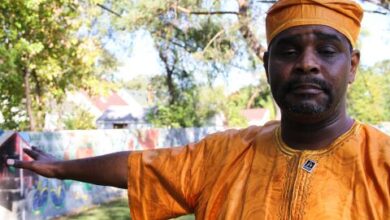Detroit segregation wall still stands, a stark reminder of racial divisions

By Erin Einhorn, NBC News, and Olivia Lewis, BridgeDetroit
July 19, 2021
This article was published in partnership with BridgeDetroit, a nonprofit community news, information and engagement media service.
DETROIT — When they started building the wall behind Margaret Watson’s house in northwest Detroit, she knew the reason without having to ask.
As a child in the late 1930s, Watson had seen the new streets laid down like a tic-tac-toe board in the open fields where her father once planted a garden the size of a city block.
She’d roller-skated down those newly paved lanes at speeds that would have been impossible on the dirt roads that ran in front of her house.
She knew the new streets had to be for white families — not Black ones like hers — so she wasn’t particularly surprised when, in the spring of 1941, a 6-foot-high, 4-inch-thick, half-mile-long concrete fortification suddenly appeared in her backyard.
If white people were moving in, she reasoned, they’d need a way to keep her out.
“I don’t remember feeling any way about it except it was the same old, same old,” said Watson, now 93, who still lives in that house and recalled being excluded from certain restaurants and stores growing up.
“I mean, I lived in Detroit all my life,” Watson said. “Detroit has been segregated all my life.”
The wall in Watson’s backyard was built by white real estate developers who struggled to secure financing for their white neighborhood until they cut it off from a Black one. It is one of a number of segregation walls built in the mid-20th century for this purpose and one of a few still standing.
The divider — called the “Birwood Wall,” the “Eight Mile Wall” or the “Wailing Wall” — can’t be blamed for inventing segregation. But the barrier, and the policies that led to its existence, would have far-reaching repercussions for the people, both Black and white, who lived in its shadow.
On the east side, the Black side, some residents were motivated by the wall’s arrival to advocate for change. Others felt penned in by the wall and the racism it represented. While the barricade, which ran through an alley between two residential streets, was not guarded and did not extend across intersections, the towering concrete sent a clear message about who was unwelcome to cross.
On the west side, the white side, some children who moved into the houses that sprouted along the new streets in the 1940s — now in their 70s and 80s — say they never knew the wall was there, just as they didn’t know that the houses their parents bought back then had deed restrictions barring residents who weren’t white. They never talked about race with their parents or friends, they said, or wondered why they attended the mostly white MacDowell Elementary School, which enrolled children from the west side of the wall, rather than the mostly Black Higginbotham School, which enrolled children from the east side.
“Race wasn’t a major issue at the time,” said Stephen Bean, 80, who is white and grew up near the wall. “Everybody just sort of got along.”
Whether people who lived near the wall knew of its existence, they were profoundly shaped by the racist policies and profiteering that built it, according to nearly three dozen interviews with current and former residents of the area and their descendants, conversations with experts and hundreds of pages of land and business records, historical documents and archival materials.
In a six-month investigation, NBC News and BridgeDetroit discovered that one of Detroit’s most prominent families built the wall and developed the adjacent white neighborhood. The reporting also examined the ways this single act of segregation has influenced generations of Detroiters.
The side of the wall these residents called home would later affect the sale price of their houses, the value of their next homes, and, eventually, the wealth they might inherit from their parents. Their experience in elementary school would determine the classes they took in high school, their decisions about college or the military, and the ease with which they achieved their goals. And throughout their lives, the friendships they made would frame their interactions with classmates and colleagues, with doctors and law enforcement, in social settings and in job interviews.
























































